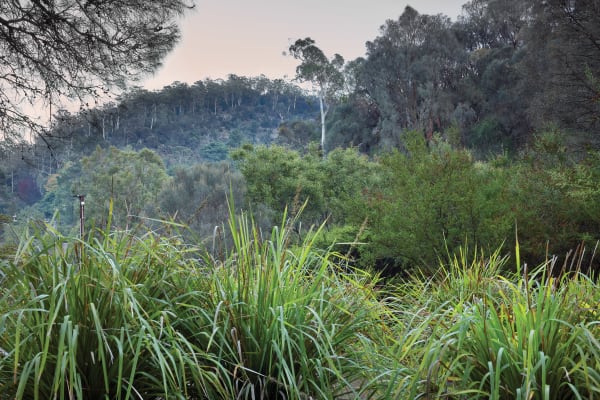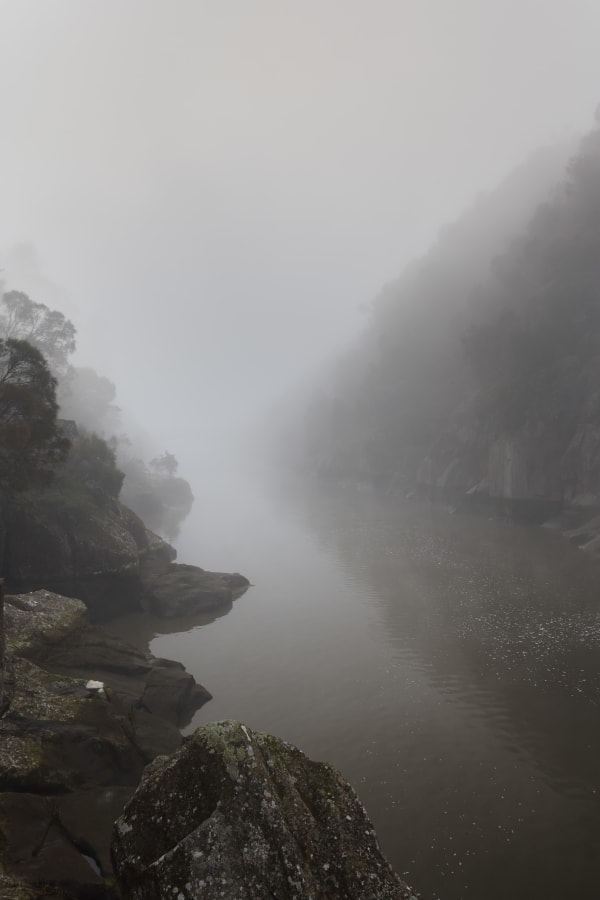There’s an irony in the name Cataract Gorge Reserve. The definition of the word “reserve” as intended here is “a place set aside for special use”. There are two examples quoted: “a reservation for an indigenous people” and “a protected area for wildlife”.
Launceston’s Cataract Gorge, a spectacular rocky formation immediately west of the city centre, is certainly set aside for special use. It’s much-vaunted as an area of “true wilderness” a short walk away from civilisation, and a jewel in the crown for tourism in northern Tasmania. However, any visitor who is engaging in more detailed looking and deeper thinking than the taking of a selfie requires, can see at a glance that its wilderness credentials are much altered.
The protection of wildlife is still a priority. Hydro Tasmania manages the flow of the South Esk River from the Trevallyn Dam, out of sight from the main part of the gorge and on past the remains of Duck Reach Power Station. The waters released from the dam nowadays make their way through the upper and lower gorge, and the company has studied the impact of varying water levels on threatened native species, such as the Cataract Gorge snail (Beddomeia launcestonensis), just two millimetres long and native to the Gorge.

Any notion that this majestic space might be reserved for indigenous people is of course an empty claim. Modern occupation has crept upon the gorge steadily for 200 years. Settlers in the early 1800s rowed boats up the South Esk and created picnic grounds on the wide rock ledges at Willow Rock. Then came a walkway on the north side, accessing the natural basin two kilometres up, and a wooden flume on the south side taking fresh water down to the city. Land which had been bought by brewer William Barnes was re-gifted by his son, swamp grounds reclaimed and a tearoom tent erected at the Cliff Grounds, where a restaurant and kiosk stand today. European, Canadian and Japanese trees were planted, their roots reaching down amongst the rocks and competing with native eucalypts for water.
Kings Bridge connected the two sides of the gorge at its entrance, Princess Alexandra Bridge crossed the waters above the basin, and turnstiles collected entry fees.
Last century there came a swimming pool, chairlift, another café, outdoor concerts, a tightrope walker and, finally, in January 2019, the staging of the national tourism industry awards, with 800 people gathered in a marquee flown in from Germany.

In the 1950s, change occurred on a more epic scale, with the building of the Trevallyn Dam and the lion’s share of the South Esk waters diverted through pipework to the Trevallyn hydroelectric power station. We may not think it when the river is in flood, but Cataract Gorge now flows with a trickle of what it once was.
Contemporary citizens in Launceston and beyond have much to thank this place for: the electricity which fuels our homes, hospitals, schools; recreation facilities and a community gathering place of arresting beauty and proximity.
Like many places in Australia, Cataract Gorge was once occupied by Aboriginals and managed with a different, more sensitive, ethic. For this reason, it’s a space I’ve always felt conflicted about.

It takes greater forces than we can invoke to change a landscape at geological level, however. I’ve long suspected there might be stories beyond the European artifice coating the surface – stories hidden in the cracks between the vast dolomite pillars and twisted sheoaks.
. . .
On a crisp autumn afternoon I’m on a walk with Geoff McLean. A historian and former teacher of aboriginal studies at the University of Tasmania, he’s a Tasmanian with of both Aboriginal and European descent. Drawing upon a rich knowledge of ancient and modern history, he tells the stories he knows with pragmatism, gentle respect and a lack of romanticism. He has conducted walking tours around the Cataract Gorge for three years.
Through the crystal light of the afternoon we listen, a small party of three, to McLean’s calm voice, itself an echo of oral history traditions, expounding upon the ways in which nature has prevailed. Gradually, he reveals to us the places where ancient stories have found sanctuary, and might just still hang in the air.

Aboriginal people were adept at firestick farming, wrapping tinder in paperbark to create a firebrand which smouldered for days. This they used to burn off plant and tree life selectively, creating grassy plains on which wildlife grazed: wallabies, pademelons, possums, rich sources of protein. Such plains have not survived, as they were used by settlers for pasture, the hard hooves of cattle and sheep destroying them.
Native flora was hardier and endured, but settlers didn’t know how to eat it, and rightly feared its toxic potential. As we circle the gorge, McLean shows us a calendar of life-giving fruit, one plant ripening after another in a year-long cycle of sustenance. Sheoaks begin the fruiting season, with seed pods edible when the furry casing is cooked off over coals. Native tomatoes survive frost and temperatures to minus eight degrees.
Kangaroo apples – shiny yellow baubles – hang on low leafy plants, unseen and yet there alongside pathways taken by countless visitors. Stripping the digestive system if eaten raw or unripe, they were cooked in the stomach of a wallaby or kangaroo over coals to make them edible. Native cherries provided a tiny tang of intense flavour and nutrients, an ancient super-food, followed by the native currant. There’s not a lot of variety, says McLean, and foraging might take all day, but there is a year-long larder.

Hunting took less time and was done at dusk, on those flat grassy plains. A creature would be disabled by a well-aimed spear, and dispatched quickly with a blow to the head from a waddy – a small club. Stocks of native wildlife were carefully managed, with the upper reaches of the Gorge, too difficult to hunt in, considered sacred breeding grounds for wildlife, and left undisturbed.
That first nation took the same care over sustaining their own population. This is a people who survived an ice age, shrinking in both numbers and occupancy of the island, but ultimately surviving. As their clans grew again in the past 10,000 years, they met regularly and women moved between them, to keep the overall population healthy. Even disputes were acted out in such a way that numbers were preserved. Instead of inflicting injuries, tribes inflicted damage, claiming victory by symbolically spearing a tree and leaving the spear as an indicator of who the disgruntled party was.
. . .
Focussed on McLean’s patter, I hardly notice that we’ve left the tarmac of the basin and are on a dirt path. As we rise into a quiet gully, the noise of rushing water falls away. Grasses nod before an imperceptible breath, and a curious, monolithic boulder stands proud and central. This is Hidden Valley, and McLean believes it to be a sacred site, perhaps for initiation ceremonies. We keep a silence for a moment, turning away and inwards, trying to absorb through some modern-day radar the meaning of the place. It has none of the trappings of the “unnatural natural space”, as McLean calls the Cliff Grounds, and yet there is a purer kind of stillness and presence.

We walk on, retracing what McLean tells us is an Aboriginal path to the top of Giant’s Grave. Unknown to many, including some park authority staff, it is a natural vantage point over the entire first basin. As we stand taking in the sweeping views to an ancient skyline, I take stock of the natural world and the unnatural. I can’t help feeling there is a bleakness as well as a majesty in what’s before us, in what we habitually do to places. It’s the closest I have ever come to survivor guilt.
Does Cataract Gorge have the spiritual resonance it once did, I wonder? McLean recounts how, following the decision to repatriate the remaining Tasmanian Aboriginals from the exile imposed on them in Wybalenna, an elder and a boy were brought to the gorge. A small party watched as the man sprang from rock to rock, singing, and becoming increasingly distressed. It’s believed that he was singing to the ancestors, whose sacred resting place was in the upper reaches of the South Esk Gorge. When no reply came, he understood that sufficient havoc had been wreaked on his culture to have vanquished not only its living but its spirits too.
The ‘true wilderness’ of the Gorge persists in its skyline, its flora and fauna, its dolerite formations and in places like Giant’s Grave and Hidden Valley, hidden in clear sight. Few landscapes that modern cultures occupy remain unchanged. Cataract Gorge may be an underlying wilderness, but signs of our occupation coat it. It is beautiful, no doubt, but ultimately a beautiful artifice – unless you look beneath.

Geoff McLean’s walks take place daily with Wallaby Walkabout Tours. For more information, see wallabywalkabouttours.com.au
Dave Groves is a Tasmanian-based lifestyle and architectural photographer. More of his work can be seen at davegroves.com.au
Fiona Stocker is a Tamar Valley-based writer, editor and keeper of pigs. She has published the books A Place in the Stockyard (2016) and Apple Island Wife (2018). More of her writing can be seen at fionastocker.com.










